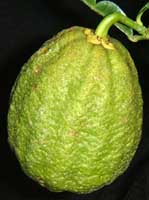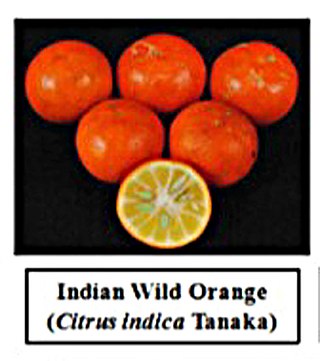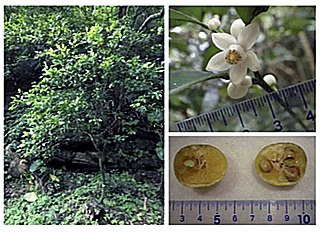
Kumquats, or cumquats in Australian English, are a group of small, angiosperm, fruit-bearing trees in the family Rutaceae. Their taxonomy is disputed. They were previously classified as forming the now-historical genus Fortunella or placed within Citrus, sensu lato. Different classifications have alternatively assigned them to anywhere from a single species, Citrus japonica, to numerous species representing each cultivar. Recent genomic analysis defines three pure species, Citrus hindsii, C. margarita and C. crassifolia, with C. × japonica being a hybrid of the last two.

Citrus is a genus of flowering trees and shrubs in the family Rutaceae. Plants in the genus produce citrus fruits, including important crops such as oranges, mandarins, lemons, grapefruits, pomelos, and limes.

Calamansi, also known as calamondin, Philippine lime, or Philippine lemon, is a citrus hybrid cultivated predominantly in the Philippines. It is native to the Philippines, parts of Indonesia, Malaysia, and Brunei, as well as parts of southern China and Taiwan.

The mandarin orange, also known as mandarin or mandarine, is a small, rounded citrus tree fruit. Treated as a distinct species of orange, it is usually eaten plain or in fruit salads. Tangerines are a group of orange-colored citrus fruit consisting of hybrids of mandarin orange with some pomelo contribution.

Citrus myrtifolia (chinotto), the myrtle-leaved orange tree, is a species of Citrus with foliage similar to that of the common myrtle. It is a compact tree with small leaves and no thorns which grows to a height of three metres (10 ft) and can be found in Malta, Libya, the south of France, and Italy (primarily in Liguria, typically Savona, and also in Tuscany, Sicily, and Calabria).

A lime is a citrus fruit, which is typically round, green in color, 3–6 centimetres (1.2–2.4 in) in diameter, and contains acidic juice vesicles.

Psyllidae, the jumping plant lice or psyllids, are a family of small plant-feeding insects that tend to be very host-specific, i.e. each plant-louse species only feeds on one plant species (monophagous) or feeds on a few closely related plants (oligophagous). Together with aphids, phylloxerans, scale insects and whiteflies, they form the group called Sternorrhyncha, which is considered to be the most "primitive" group within the true bugs (Hemiptera). They have traditionally been considered a single family, Psyllidae, but recent classifications divide the group into a total of seven families; the present restricted definition still includes more than 70 genera in the Psyllidae. Psyllid fossils have been found from the Early Permian before the flowering plants evolved. The explosive diversification of the flowering plants in the Cretaceous was paralleled by a massive diversification of associated insects, and many of the morphological and metabolic characters that the flowering plants exhibit may have evolved as defenses against herbivorous insects.

Citrus unshiu is a semi-seedless and easy-peeling citrus species, also known as the satsuma mandarin or Japanese mandarin. During the Edo period of Japan, kishu mikans were more popular because there was a popular superstition that eating Citrus unshiu without seeds made people prone to infertility. Citrus unshiu became popular in Japan after modernization started in the Meiji period. It was introduced to the West from the Satsuma region of Japan in 1878.

The trifoliate orange, Citrus trifoliata, is a member of the family Rutaceae. Whether the trifoliate oranges should be considered to belong to their own genus, Poncirus, or be included in the genus Citrus is debated. The species is unusual among citrus for having deciduous, compound leaves and pubescent (downy) fruit.

Citrus australis, the Dooja, round lime, Australian lime or Australian round lime, is a large shrub or small tree producing an edible fruit. It grows in forest margins in the Beenleigh area and northwards, in Queensland, Australia.

Papeda or papaeda is the common name for a group of Citrus species and varieties native to tropical Asia that are hardy and slow-growing, and produce unpalatable fruit. Walter Tennyson Swingle segregated these species into a separate subgenus, Papeda, that included the Ichang lemon, yuzu, kaffir lime, kabosu, sudachi, and a number of wild and uncultivated species and hybrids. Recent genetic analysis shows the papedas to be distributed among distinct branches of the Citrus phylogenetic tree, and hence Swingle's proposed subgenus is polyphyletic and not a valid taxonomic grouping, but the term persists as a common name.
Citrus undulata, synonym Oxanthera undulata, the wavy-leaf oxanthera, is a species of plant in the family Rutaceae. It is endemic to New Caledonia. Oxanthera undulata is classified as critically endangered by the IUCN.

Citrus macroptera, natively known as shatkora or cabuyao, Melanesian papeda, or wild orange, is a semi-wild species of citrus native to the Sylhet region of Bangladesh and the Barak Valley Division of the Indian state of Assam.

Cold-hardy citrus is citrus with increased frost tolerance and which may be cultivated far beyond traditional citrus growing regions. Citrus species and citrus hybrids typically described as cold-hardy generally display an ability to withstand wintertime temperatures below −5 to −10 °C. Cold-hardy citrus may be generally accepted 'true' species or hybrids involving various other citrus species. All citrus fruits are technically edible, though some have bitter flavors often regarded as unpleasant, and this variability is also seen in cold-hardy citrus fruits. Those listed as "inedible fresh" or "semi-edible" can be cooked to make marmalade.
Mussidia pectinicornella is a species of snout moth in the genus Mussidia. It was described by George Hampson in 1896. It is found in southern and south-eastern Asia from Bhutan to New Guinea, in Australia and Fiji, Taiwan, Japan, southern Europe and in Réunion.

The micrantha is a wild citrus from the papeda group, native to southern Philippines, particularly islands of Cebu and Bohol. Two varieties are recognized: small-flowered papeda, locally known as biasong, and small-fruited papeda or samuyao.

Citrus indica is a species of hybrid Citrus known by the common name Indian wild orange.
Citrus warburgiana. the kakamadu or New Guinea wild lime, grows on the south coast of the Papuan Peninsula near Alotau in Papua-New Guinea.

Citrus taxonomy refers to the botanical classification of the species, varieties, cultivars, and graft hybrids within the genus Citrus and related genera, found in cultivation and in the wild.

Citrus ryukyuensis, also known as the tanibuta, is a newly characterized wild citrus species native to the Ryukyus and adjacent islands, most closely related to the mainland mandarin orange, C. reticulata. As with other citrus, it is a member of the Rutaceae family. The Ryukyu and mainland species have diverged for more than 2 million years, and unlike the mainland mandarin, the Ryukyu mandarin reproduces sexually. Its hybridization with the mainland species has given rise to the unique mandarin hybrids of the islands.
















